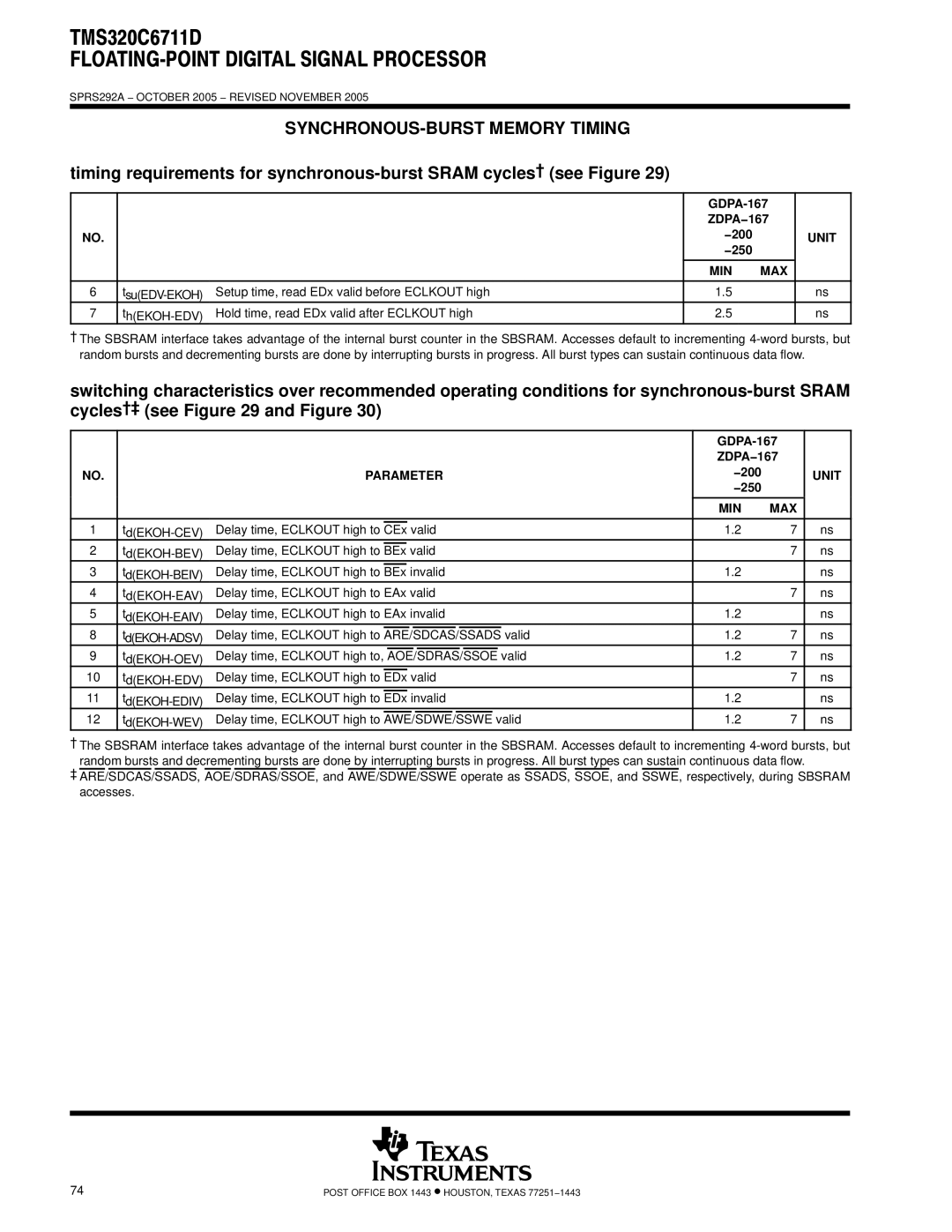
SPRS292A − OCTOBER 2005 − REVISED NOVEMBER 2005
SYNCHRONOUS-BURST MEMORY TIMING
timing requirements for | (see Figure 29) |
|
| |||
|
|
|
|
|
| |
|
|
|
| ZDPA−167 |
| |
NO. |
|
|
| −200 |
| UNIT |
|
|
|
| −250 |
|
|
|
|
|
| MIN | MAX |
|
|
|
|
|
|
|
|
6 | Setup time, read EDx valid before ECLKOUT high |
| 1.5 |
| ns | |
7 | Hold time, read EDx valid after ECLKOUT high |
| 2.5 |
| ns | |
†The SBSRAM interface takes advantage of the internal burst counter in the SBSRAM. Accesses default to incrementing
switching characteristics over recommended operating conditions for
|
|
|
|
|
|
|
|
|
|
|
|
|
|
|
|
|
|
|
|
|
|
| |
|
|
|
|
|
|
|
|
|
|
|
|
|
|
|
|
|
|
|
|
| ZDPA−167 |
| |
NO. |
| PARAMETER | −200 |
| UNIT | ||||||||||||||||||
|
|
|
|
|
|
|
|
|
|
|
|
|
|
|
|
|
|
|
|
| −250 |
|
|
|
|
|
|
|
|
|
|
|
|
|
|
|
|
|
|
|
|
|
|
| MIN | MAX |
|
|
|
|
|
|
|
|
|
|
|
|
|
|
|
|
|
|
|
|
|
|
|
|
|
1 | Delay time, ECLKOUT high to |
|
|
|
|
| valid | 1.2 | 7 | ns | |||||||||||||
CEx |
|
| |||||||||||||||||||||
2 | Delay time, ECLKOUT high to |
|
|
|
|
| valid |
| 7 | ns | |||||||||||||
BEx |
|
|
| ||||||||||||||||||||
3 | Delay time, ECLKOUT high to |
|
|
|
|
| invalid | 1.2 |
| ns | |||||||||||||
BEx |
|
|
| ||||||||||||||||||||
4 | Delay time, ECLKOUT high to EAx valid |
| 7 | ns | |||||||||||||||||||
5 | Delay time, ECLKOUT high to EAx invalid | 1.2 |
| ns | |||||||||||||||||||
8 | Delay time, ECLKOUT high to |
|
|
|
|
|
|
|
|
|
|
|
|
|
|
|
|
|
| 1.2 | 7 | ns | |
|
|
|
|
| ARE/SDCAS/SSADS valid | ||||||||||||||||||
9 | Delay time, ECLKOUT high to, |
|
|
|
|
|
|
|
|
|
|
|
|
|
|
|
|
| 1.2 | 7 | ns | ||
|
|
| AOE/SDRAS/SSOE valid | ||||||||||||||||||||
10 | Delay time, ECLKOUT high to |
|
|
|
| valid |
| 7 | ns | ||||||||||||||
EDx |
| ||||||||||||||||||||||
11 | Delay time, ECLKOUT high to |
|
|
|
| invalid | 1.2 |
| ns | ||||||||||||||
EDx |
| ||||||||||||||||||||||
12 | Delay time, ECLKOUT high to |
|
|
|
|
|
|
|
|
|
|
|
|
|
|
|
|
|
| 1.2 | 7 | ns | |
AWE/SDWE/SSWE valid | |||||||||||||||||||||||
†The SBSRAM interface takes advantage of the internal burst counter in the SBSRAM. Accesses default to incrementing
‡ARE/SDCAS/SSADS, AOE/SDRAS/SSOE, and AWE/SDWE/SSWE operate as SSADS, SSOE, and SSWE, respectively, during SBSRAM accesses.
74 | POST OFFICE BOX 1443 • HOUSTON, TEXAS 77251−1443 |
